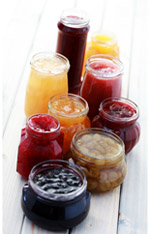
As berries and other fruits ripen, many think about preserving the harvest in a sweet form, such as jellies, jams or other sweet spreads. University of Missouri Extension recently released an updated publication called How to Can Sweet Spreads and Syrups (GH1461) that explains sugar’s role in these tasty treats and offers some alternatives for those who are concerned about consuming too much sugar.
Although one might be tempted to simply leave out the sugar in a jam or jelly recipe, or to use a sugar substitute to make it lower in sugar and calories, this is not recommended when preserving them. In fact, the sugar plays an important role in getting the gelled consistency that is characteristic of these items. Sugar interacts with the natural pectin in fruits like apples, crabapples, gooseberries, and some plums and grapes to form a gel. Likewise, the sugar is needed with the regular pectin that would be added to strawberries, cherries and blueberries to form a gel for a jam or jelly. In these tested recipes, the sugar also helps to prevent the growth of molds and yeasts in the canned jars of sweet spreads.
To reduce the sugar in sweet spreads, there are several options. Special types of pectin have been specifically modified for use with less sugar or with sugar substitutes. Watch the label for these particular products and follow the directions on the package. Some tested recipes recommend boiling the fruit for a longer time than usual, with the resulting thickening taking the place of the usual gel that pectin produces. Other tested recipes use gelatin to thicken the sweet spread, but this process requires the resulting product to be stored in the refrigerator or freezer.
For more information on making jams, jellies and other sweet spreads, and for recipes made without sugar, with less sugar or with sugar substitutes, refer to MU Extension publication GH1461, How to Can Sweet Spreads and Syrups. These recipes have been tested for safety and they will result in a satisfactory gelled product.